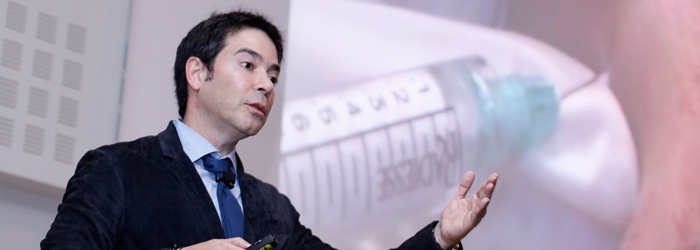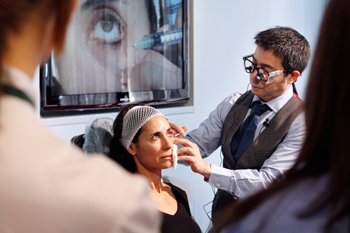This morning, Dr José Raúl Montes, one of the biggest international names in oculoplastic surgery, showed 200 colleagues from around the world the latest non-invasive cosmetic trends and techniques used in facial rejuvenation or restoration cases, during the second and final day of the oculoplastics course held at the Barcelona Institute of Ocular Microsurgery.
During a conference prior to the practical workshop, Dr Montes highlighted the increased use of biostimulating fillers, such as polylactic acid (PLA), a liquid substance that encourages the body's cells to generate collagen thus re-establishing or restoring some areas where support has been lost. According to this specialist, this trend is the result of a new concept of facial ageing. "Whereas previously plastic surgeons focused their work almost exclusively on skin stretching, they now seek to re-establish or restore, by injecting volume using less invasive techniques. They no longer treat wrinkles as an isolated issue, but look at the patient's aesthetic needs as a whole. In the case of fillers, this means injecting into a greater number of areas safe substances that provide support and lift where there is volume loss" says Dr Montes.
Initially, this dermal filler was first used in Europe as a treatment for patients withlipodystrophy or loss of facial fat associated with HIV. In these cases, the improvement was considerable and was approved by the FDA (Food and Drug Administration) in 2008 for cosmetic use in the restoration of any facial volume lost, the establishment of support, as well as improvement to the lines, structure and quality of the skin. According to Dr Montes, “polylactic acid acts gradually and requires between 3 and 4 sessions to be able to see the changes, the effects of which last for 2 to 3 years. “Compared to other fillers (hyaluronic acid, calcium hydroxyapatite), PLA provides the patient with much more natural facial results", he concludes.
Botulinum toxin, the most requested substance
The theoretical-practical workshop on the application of periocular injectables also dealt with the use of botulinum toxin, a substance indicated for both functional (exophthalmos, blepharospasms, etc.) and aesthetic pathologies (correction of expression lines (crow's feet, frown lines and interciliary lines). Approved for aesthetic use in 2002, botulinum toxin is currently the most requested minimally invasive cosmetic treatment worldwide. According to Dr Montes, “it is a one hundred percent safe substance, but which must always be administered by experts such as ophthalmologists specialised in oculoplastic surgery”.
Apart from discussing the use of another periocular filler, Dr Montes wanted to make his colleagues aware of the importance of looking at and assessing each patient, not just from an aesthetic point of view. According to the Puerto Rican specialist, "speaking to and observing the patient is key when deciding which treatment or product is the most suitable for their particular case. An assessment that should not end with the face but should explore the patient's personality, nature and motivations and, ultimately, learn to look inside”.
This workshop closes the second day of the 3rd International Barcelona Oculoplastics Course, organised by IMO Foundation, which showed eight live eyelid procedures yesterday. Most notable of the procedures was the transconjunctival mid-face lift con injerto de tejido with a tissue grafting from the mucous membrane of the palate to correct lower eyelid retraction following a blepharoplasty operation. This complex procedure, which is pioneering in Europe, was successfully performed by Dr Ramón Medel, oculoplastic surgery specialist at IMO and course director

